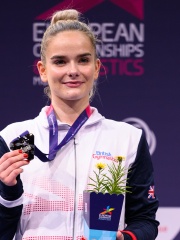ATHLETE
Loubna Benhadja
2001 - Today

 Loubna Benhadja
Loubna Benhadja
Loubna Benhadja (born 11 February 2001) is an Algerian athlete. She competed in the women's 400 metres hurdles event at the 2020 Summer Olympics. Read more on Wikipedia
Her biography is available in 9 different languages on Wikipedia. Loubna Benhadja is the 9,945th most popular athlete (down from 8,374th in 2024), the 250th most popular biography from Algeria (down from 233rd in 2019) and the 28th most popular Algerian Athlete.
Memorability Metrics
Page views of Loubna Benhadja by language
Among ATHLETES
Among athletes, Loubna Benhadja ranks 9,945 out of 6,025. Before her are Oliver Townend, Nikita Ducarroz, Armin Hadipour, Candelaria Herrera, Emmanuel Matadi, and Ane Marcelle dos Santos. After her are Andrea Deelstra, Jiang Yan, Mike Foppen, Zach Phillips, Julia Hassler, and Kinaua Biribo.
Most Popular Athletes in Wikipedia
Go to all RankingsOliver Townend
1982 - Present
HPI: 25.16
Rank: 9,940
Nikita Ducarroz
1996 - Present
HPI: 25.15
Rank: 9,941
Armin Hadipour
HPI: 25.15
Rank: 9,942
Candelaria Herrera
1999 - Present
HPI: 25.15
Rank: 9,943
Emmanuel Matadi
1991 - Present
HPI: 25.15
Rank: 9,944
Ane Marcelle dos Santos
1994 - Present
HPI: 25.14
Rank: 9,945
Loubna Benhadja
2001 - Present
HPI: 25.14
Rank: 9,946
Andrea Deelstra
1985 - Present
HPI: 25.12
Rank: 9,947
Jiang Yan
HPI: 25.12
Rank: 9,948
Mike Foppen
1996 - Present
HPI: 25.12
Rank: 9,949
Zach Phillips
1986 - Present
HPI: 25.12
Rank: 9,950
Julia Hassler
1993 - Present
HPI: 25.12
Rank: 9,951
Kinaua Biribo
1993 - Present
HPI: 25.11
Rank: 9,952
Contemporaries
Among people born in 2001, Loubna Benhadja ranks 543. Before her are Alice Kinsella, Jess Park, Takaya Yoshinare, Ulysses Llanez, Riku Kobayashi, and Seiichiro Kubo. After her are Riyon Tori, Sosuke Shibata, R. J. Hampton, TyTy Washington Jr., Riku Nakayama, and Sho Iwamoto.
Others Born in 2001
Go to all RankingsAlice Kinsella
GYMNAST
2001 - Present
HPI: 25.44
Rank: 537
Jess Park
SOCCER PLAYER
2001 - Present
HPI: 25.43
Rank: 538
Takaya Yoshinare
SOCCER PLAYER
2001 - Present
HPI: 25.38
Rank: 539
Ulysses Llanez
SOCCER PLAYER
2001 - Present
HPI: 25.38
Rank: 540
Riku Kobayashi
SOCCER PLAYER
2001 - Present
HPI: 25.36
Rank: 541
Seiichiro Kubo
SOCCER PLAYER
2001 - Present
HPI: 25.16
Rank: 542
Loubna Benhadja
ATHLETE
2001 - Present
HPI: 25.14
Rank: 543
Riyon Tori
SOCCER PLAYER
2001 - Present
HPI: 25.08
Rank: 544
Sosuke Shibata
SOCCER PLAYER
2001 - Present
HPI: 24.99
Rank: 545
R. J. Hampton
BASKETBALL PLAYER
2001 - Present
HPI: 24.92
Rank: 546
TyTy Washington Jr.
BASKETBALL PLAYER
2001 - Present
HPI: 24.91
Rank: 547
Riku Nakayama
SOCCER PLAYER
2001 - Present
HPI: 24.83
Rank: 548
Sho Iwamoto
SOCCER PLAYER
2001 - Present
HPI: 24.83
Rank: 549
In Algeria
Among people born in Algeria, Loubna Benhadja ranks 253 out of 213. Before her are Yasser Larouci (2001), Sonia Asselah (1991), Chouaib Bouloudinat (1987), Abdelkarim Fergat (1994), Hamza Bouras (1987), Oussama Sahnoune (1992), Walid Bidani (1994), Fethi Nourine (1991), and Slimane Moula (1999). After her are Mohammed Houmri (1993), Younes Nemouchi (1993), and Nadjet Berrichi (1995).
Others born in Algeria
Go to all RankingsYasser Larouci
SOCCER PLAYER
2001 - Present
HPI: 32.68
Rank: 244
Sonia Asselah
WRESTLER
1991 - Present
HPI: 31.79
Rank: 245
Chouaib Bouloudinat
ATHLETE
1987 - Present
HPI: 31.52
Rank: 246
Abdelkarim Fergat
WRESTLER
1994 - Present
HPI: 29.54
Rank: 247
Hamza Bouras
ATHLETE
1987 - Present
HPI: 29.10
Rank: 248
Oussama Sahnoune
SWIMMER
1992 - Present
HPI: 27.92
Rank: 249
Walid Bidani
ATHLETE
1994 - Present
HPI: 26.86
Rank: 250
Fethi Nourine
ATHLETE
1991 - Present
HPI: 26.79
Rank: 251
Slimane Moula
ATHLETE
1999 - Present
HPI: 25.23
Rank: 252
Loubna Benhadja
ATHLETE
2001 - Present
HPI: 25.14
Rank: 253
Mohammed Houmri
ATHLETE
1993 - Present
HPI: 23.82
Rank: 254
Younes Nemouchi
ATHLETE
1993 - Present
HPI: 22.82
Rank: 255
Nadjet Berrichi
ATHLETE
1995 - Present
HPI: 20.66
Rank: 256
Among ATHLETES In Algeria
Among athletes born in Algeria, Loubna Benhadja ranks 28. Before her are Hicham Bouchicha (1989), Chouaib Bouloudinat (1987), Hamza Bouras (1987), Walid Bidani (1994), Fethi Nourine (1991), and Slimane Moula (1999). After her are Mohammed Houmri (1993), Younes Nemouchi (1993), Nadjet Berrichi (1995), Claudymar Garcés (1998), Yang Hengyu (1996), and Salim Heroui (1999).
Hicham Bouchicha
1989 - Present
HPI: 32.77
Rank: 22
Chouaib Bouloudinat
1987 - Present
HPI: 31.52
Rank: 23
Hamza Bouras
1987 - Present
HPI: 29.10
Rank: 24
Walid Bidani
1994 - Present
HPI: 26.86
Rank: 25
Fethi Nourine
1991 - Present
HPI: 26.79
Rank: 26
Slimane Moula
1999 - Present
HPI: 25.23
Rank: 27
Loubna Benhadja
2001 - Present
HPI: 25.14
Rank: 28
Mohammed Houmri
1993 - Present
HPI: 23.82
Rank: 29
Younes Nemouchi
1993 - Present
HPI: 22.82
Rank: 30
Nadjet Berrichi
1995 - Present
HPI: 20.66
Rank: 31
Claudymar Garcés
1998 - Present
HPI: 20.23
Rank: 32
Yang Hengyu
1996 - Present
HPI: 16.75
Rank: 33
Salim Heroui
1999 - Present
HPI: 15.43
Rank: 34








































